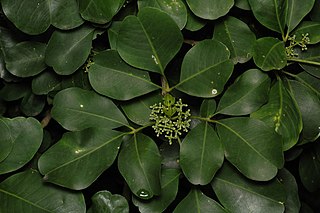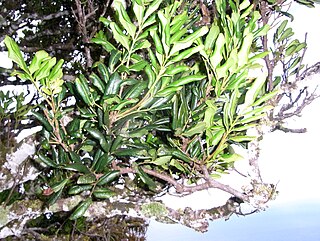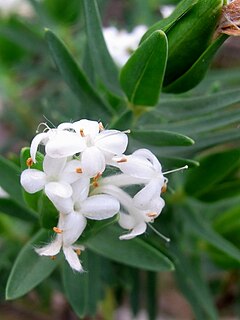
Coprosma is a genus of flowering plants in the family Rubiaceae. It is found in New Zealand, Hawaiian Islands, Borneo, Java, New Guinea, islands of the Pacific Ocean to Australia and the Juan Fernández Islands.

Coprosma repens is a species of flowering shrub or small tree of the genus Coprosma, in the family Rubiaceae, native to New Zealand. Common names include taupata, tree bedstraw, mirror bush, looking-glass bush, New Zealand laurel and shiny leaf.

Coprosma perpusilla, commonly known as creeping coprosma, is a species of flowering plant in the family Rubiaceae. It is found in Australia, New Zealand and on some subantarctic islands. The specific epithet comes from the Latin per (very) and pusillus, referring to the growth habit.
Piper hooglandii, commonly known as kava, is a flowering plant in the family Piperaceae. The specific epithet honours Dutch botanist Ruurd Dirk Hoogland.
Coprosma huttoniana is a flowering plant in the family Rubiaceae. The specific epithet honours Ian Hutton, the Lord Howe Island based naturalist who discovered the plant and recognised it as a new species.
Coprosma inopinata is a flowering plant in the family Rubiaceae. The specific epithet comes from the Latin inopinus (“unexpected”), because it was discovered unexpectedly in 1989, proving to be yet another species of Coprosma that was endemic to Lord Howe Island.
Coprosma lanceolaris is a flowering plant in the family Rubiaceae. The specific epithet comes from the Latin lancea with the suffix -aris, alluding to the shape of the leaves.

Coprosma prisca, commonly known as goatwood, is a flowering plant in the family Rubiaceae. The Latin specific epithet prisca means “old” or “ancient”, though its application to this species is unknown.
Psychotria carronis, commonly known as the black grape, is a flowering plant in the coffee family. The specific epithet honours William Carron (1823–1876) who collected plants on Lord Howe Island for the Royal Botanic Gardens, Sydney.
Melicope contermina is a species of shrub or small tree in the family Rutaceae and is endemic to Lord Howe Island. It has trifoliate leaves and white flowers borne in leaf axils in panicles of nine to fifteen flowers.

Melicope polybotrya is a species of shrub or small tree in the family Rutaceae and is endemic to Lord Howe Island. It has trifoliate leaves and green flowers borne in short panicles in leaf axils.
Exocarpos homalocladus, commonly known as the grass tree, is a flowering plant in the sandalwood family. The specific epithet comes from the Greek homalos (“flat”) and clados, with reference to the structure of the plant.

Guioa coriacea , commonly known as cedar or island cedar, is a flowering plant in the family Sapindaceae. The specific epithet refers to the coriaceous (leathery) leaves.

Pimelea congesta is a flowering plant in the Thymelaeaceae family. The specific epithet refers to the congested inflorescence.
Celtis conferta subsp. amblyphylla, commonly known as cotton wood or cotton-wood, is a flowering plant in the hemp and hackberry family.
Melicytus novae-zelandiae subsp. centurionis is a flowering plant in the family Violaceae. It is a subspecies of Melicytus novae-zelandiae, known in New Zealand as coastal mahoe. The subspecific epithet honours the military Captain James Doran McComish (1881–1948), who made several visits in the 1930s to collect plants on Lord Howe Island.
Leptospermum polygalifolium subsp. howense, commonly known as tea tree or tea-tree, is a flowering plant in the myrtle family, Myrtaceae. The subspecific epithet refers to the island to which the subspecies is endemic.
Passiflora herbertiana subsp. insulae-howei is a flowering plant in the passion flower family. The subspecific epithet refers to the island to which the subspecies is endemic.
Pouteria myrsinoides subsp. reticulata, commonly known as axe-handle wood, is a flowering plant in the sapodilla family, Sapotaceae. The subspecific epithet refers to the reticulate venation on the leaves.
Boehmeria calophleba is a flowering plant in the nettle family.







